As a photo organizer, I often comes across memorabilia other than photos. Those dusty boxes that are brought up from the basement don’t just hold prints, oh no. They also hold decades-old home movies, heirlooms, baby keepsakes, and other things that are precious to my clients. Things that take up space – sometimes a lot of space – but because they’re sentimental, they can’t be thrown away just like that. One of the major challenges then becomes: how can we ensure that the story stays with the item? Well, I use a method called twin labeling (or “twin check labeling” as it’s officially named) to help solve that problem, and in today’s post, I want to share with you how this method can help you stay organized too! I know it doesn’t sound like it would make a world of difference, but sometimes it’s the little things!
Keep or Toss That Keepsake?
So you’ve found your great grandmother’s old brooch. Now what? Should you wear it? Toss it? Archive it?
Well, that decision is really up to you. In most situations, I’m in favor of keeping heirlooms because of the sentimental value. That clearly comes from the genealogical side of me. However, my professional organizer side also gets a say (you can now mentally picture a little archivist and a little declutterer – one on each shoulder…lol). In short, my rule is: if the story isn’t attached to the item, it has to go. This is one of the conditions I give my clients when they’re on the fence about what to do with certain items. Why? Because it prompts action and a decision, which is usually the push they need.
The tricky part about heirlooms is that they can’t be replaced, unlike that bunch of clutter you just bought last week. They do deserve special treatment because they’re a part of your family history. However, if you’re not going to take care of your item or make sure that your descendants know the story of it, what’s the use in keeping it? The whole point becomes moot. An heirloom without a story is just more clutter, and if no one if your family knows the story behind it, why it was valued, and why it should continue to be valued, you might as well get rid of it because it’s worthless.
Storing the Stories
So what are some ways you can keep the stories alive? Well, before you do anything else, you have to write them down. Getting them on paper is step one. To do that, think about your items and what someone (who knows nothing about your family history) might need to find out to understand the value of them. Who owned a particular item? Where did that person get it, and why? How much was it? Why was it valued and passed down the generations? You’ll also want to take a good photo of the item in question. Years from now, they’ll appreciate the information because your heirloom won’t be so “obvious” anymore.
Now that you have all of that information, you can do one of two things: 1) create a photo book of the memory, and then let go of the physical item, or 2) archive the physical item along with the story. It’ll come as no surprise to you that most people choose option #2, storing the item. But that’s easier said than done. How do you ensure that the story stays with the item? Well, to help people tell their stories in an organized manner, I rely a lot on twin labeling. If you remember, my rule is that if a client wants to keep their heirloom, steps need to be taken towards properly archiving it. Twin check labeling is one of those steps, and although it’s not foolproof, it’s a very elegant system for staying organized. Let’s dig into it!
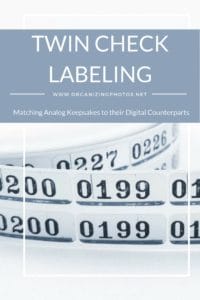
I’m a Perfect Pinnable!
What Exactly are Twin Check Labels?
Twin check labels are labels that are used in film and photo processing labs to make it easy for employees to match up a roll of processed film to something else, for example a person, or a specific envelope. Sometimes, they’re also used during the developing process itself. They look just like regular labels, except for the fact that there’s two of them – a set of twins – that carry the same number (hence the term “twin labeling”). The purpose is to have one label on one item, and another label (with the same number) on another item, so that it becomes easy to match the two items up without having to look at records or any other details.
There are different types of twin labels out there on the market. Some are made out of polyester and meant to withstand the different temperatures that happen during the development of film. Can’t have labels falling off left and right now, can we? Other twin check labels are simpler and look more like regular stickers. Those are meant to be used like regular labels that you print from a label maker because they aren’t a very good fit for film processing. I don’t expect that most of my readers develop film, so I’ll be focusing on basic twin check labels in this post because if you’re a film lab reading this, you probably already know what to do. Right?
4 Great Ways to Use Twin Check Labels
Like I mentioned earlier, the purpose of twin check labels is to make it easy for anyone to see what items go together. As you can imagine, this is great for so many reasons! Any good organizing system should be fairly obvious to understand, and this is about as easy as it can get.
Here are my favorite ways to use twin check labels:
1. When Sorting Printed Photos
If you find yourself in a situation where you have hundreds (or even thousands) of printed photos to sort through, twin labels can help you stay organized during the process! You won’t be able to finish everything in one day, so you need a system that is easy to remember. If you’re not doing any labeling as you go, this stop-and-start process can get confusing, especially if more than a few days pass by before you get back to your project again. You need to be able to pick up where you left off fast, and twin check labels lets you see more easily where exactly that was.
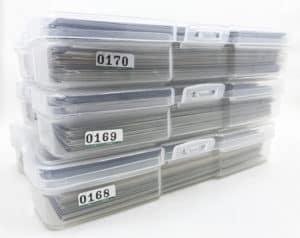
Sorting with twin check labels speeds up your process!
For most of my projects, I like to sort in these plastic photo storage containers. They’re not so great for permanent photo storage (the polypropylene locks in moisture), but they’re amazing for sorting. I put a twin label on each individual case, and then match up that case to a form where I record what I know about the moment the photo was taken. This way, I sort photos into the correct cases as I go, and at the same time, I collect descriptions that go along with them. It’s not often that a photo has all the information written on the back, but it’s very common for a few photos (taken at the same event) to carry a little bit of information each…One photo will have the year; another one might have a caption of who’s in it, and so on. Recording this information in a single place helps me get the full picture (pardon the pun!), and because the form is twin labeled, I can easily match it up to the correct case of photos at any time. This system makes it really easy to stop and start again without having to remember too much! And if you’re scanning the photos later on, your metadata is already done. #Bonus.
2. When Digitally Archiving Heirlooms
Let’s say you have a physical heirloom that you really want to keep, but you also want to preserve a digital versions of it, perhaps that brooch we talked about in the beginning of this article? How would you go about that? Well, a great way to do that is with twin check labeling! I would take a really good photo of the item (using my ShotBox or another simple setup), and then write down the story of the item. I would then put the brooch in an archival-safe box labeled with the first twin check. In my digital archive, I would label or keyword the file with the same number so it corresponds to the physical box. If I have the story in a PDF, for example, I would also label that file with the exact same number once again, and voilà, the items would be perfectly synced.
Would the second twin check label go to waste, I hear you asking? Maybe, if all I wanted was the digital version. But I would probably print out that PDF and put the second sticker on it, and store it safely along with the original heirloom. If I had written the story down by hand, I might have used the second label for that instead. You’re only limited by your imagination and the amount of labels you can afford!
This type of organizing works on more than heirlooms, I should add. I use this same technique with home movies, slides, and negatives almost every week!
3. On Intake Forms
When I receive a bunch of home movies to digitize, I usually have an intake form that accompanies the order. That intake form carries all the information I receive about each individual home movie, for example the approximate year it was filmed, the names of the people who are in it, the copyright owner, and so on. Much of this information is provided to me by the client, but I also make my own *internal* notes on it, such as the format it’s in, the output format for the conversion, and if the film is damaged in any way. Things like that. To help me with this process, I use twin check labels every. single. time.
Here’s how: First, I put the first twin check on the actual tape or film (in a discrete place, of course), and then I put the second one on the form itself. That way, I always know which tape matches up to the correct information. It helps me be much more efficient in organizing and converting the originals to digital files, and it saves me time because I already have much of the metadata ready to go. Oh, and did I mention that the digital file also carries the same number? Go ahead – call me the Triple Check Queen.
Wait, do triple check labels exist? Yes, they actually do, but they’re not as common, and you’ll most likely never need those unless you have several parts to an heirloom, or you have a more complicated system with multiple moving parts.
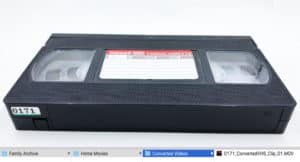
Using twin labeling on converted home movies lets you match up the original tape with the digital file! This is helpful if you’re saving your originals, and if you ever want to find a clip to convert at a higher resolution! Maybe not so much for VHS tapes, but definitely for film reels!
4. In Indexed Clip Books
Sometimes, if I have a really large home movie archive to digitize for a client, I create a custom clip book (something I learned from our friends over at EverPresent). This is basically a custom binder with an index of all the movie clips (with screenshots and details on how they match up to the originals). The custom binder pages are made up of “clip profiles” (similar to the intake forms that I mentioned earlier) that includes the who, what, when, where, and why – plus a screenshot of best moment. All you photographers out there can liken it to a contact sheet with info. Twin labeling is obviously a must in this process, and I apply the same technique as I explained in tip #2. In this case, the home movies get the “heirloom” treatment, as I cheekily call it.
Using an indexed clip book lets my clients look up a specific clip, and then go directly to the correct DVD or file to watch it. It also works the other way around. Clients can watch any clip and then just flip to the correct page in the clip book to write down what they remember about the event. Sometimes, clients want me to fill in all the info before the final delivery, and sometimes they ask for blank pages, so they can fill them out themselves as they watch their home movies. Either way, it’s a beautiful way to apply twin labeling and keep a really organized home movie archive. Come to think of it, this system might warrant its own blog post…
Why You Should Use Twin Check Labels
(Hint: It’s cheaper!)
If you’re just labeling a few things, there’s really no need for you to buy an “official” twin check label kit because, let’s face it, you’re never going to use them all up. But if you’re a budding photo organizer, or someone who takes on clients, it can really help you to stock up, not only in terms of workflow but also for economic reasons. A regular good ol’ label maker (my favorite is the Brother P-Touch) will run you about $20-30 ($10 on sale!), but that’s not where they get ya, and you know that. Just like printers and their overpriced ink, label makers run through a lot of tape, and each tape will cost you at least another $20 each time you need a new one. If you’re printing a lot of labels, that can get really expensive. Twin labels on the other hand tend to be much cheaper, and they’re ready to go, which I love! Plus, regular label maker tape isn’t exactly what I would call “photo-safe”!
Where to Get Twin Check Labels
If you decide on purchasing labels after reading this post, double-check that they’re archival (or at-least photo-safe), so you can use them in all situations. That way you don’t have to worry about sticking them to your photos and other treasures.
In the US, you can buy them from Pakor, Inc. in Minnesota at a very reasonable price. I believe it’s just under $11 for 2000 labels, which makes them way cheaper than printing your own with a regular label maker. They carry a lot of great products, so if you’re a business owner, I recommend trying them out!
If you are in the UK, you can get twin check labels from Process Supplies, which is a photo supply shop in London, and if you’re somewhere else in Europe, buy them from FotoFlex Minilab in Germany. If you’re reading this from somewhere in Asia, I believe there is a supply store in Bangalore (India), but I’ve never dealt directly with them, so now that I’ve told you what to buy, that research is on you!

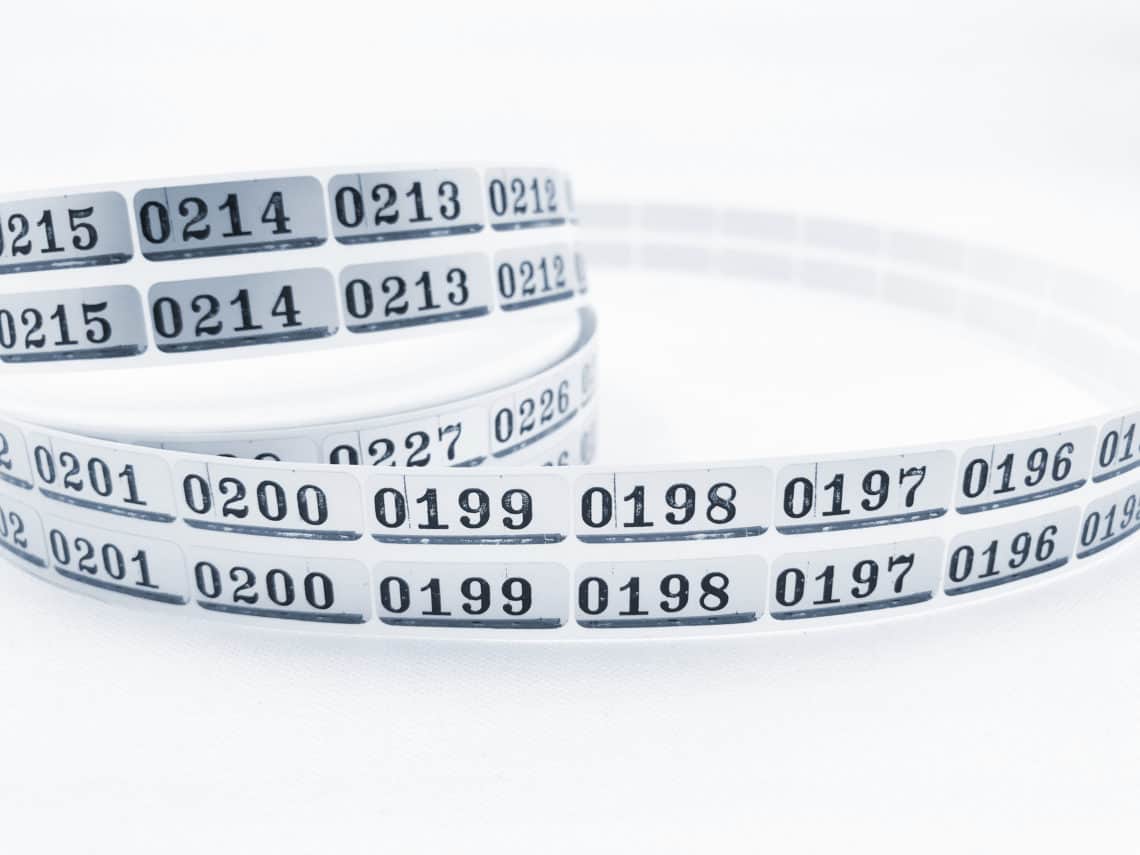


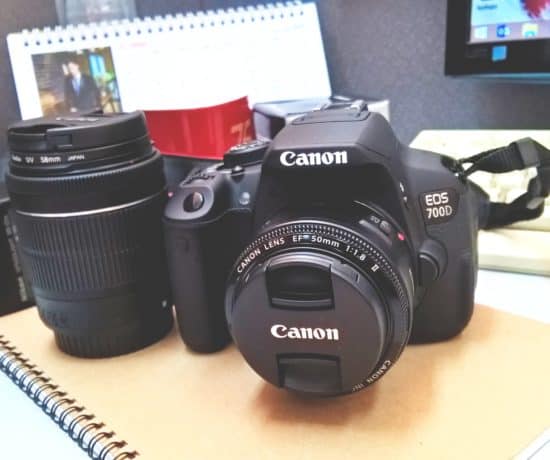

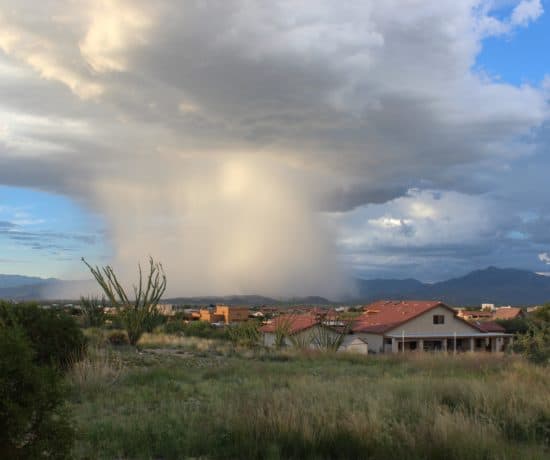
Kim
March 16, 2017 at 10:17 amI found the same twin check labels with Liberty2Create.com, a subsidiary of Pakor, and was able to buy them without the $50 minimum. Love your blog and this post!! I learned something new, and am very excited to continue organizing my photographs.
Caroline Guntur
March 16, 2017 at 2:12 pmThat’s great, Kimberly! Thanks for sharing your source!
Kathy Robinson
March 24, 2017 at 3:21 pmKim, thanks for the tip! I ordered from Liberty even though the shipping charge was really high. I was SO pleasantly surprised to receive an invoice where they billed me the actual shipping charge instead (which was low because I am only a state away). I had my roll the day after I placed the order, too!
Caren Osborne
May 17, 2017 at 5:31 pmI just used a version of twin check labels with organizing print photos. I am working on removing photos and memorabilia from a client’s albums and sorting the photos into an archival safe box. Some of the photos and memorabilia are too big for the smaller containers in the box but I want to notate where they were would fall into the date organization in the box. I labeled index cards 1001 to 1050 (to start) and used those to place in the box where the larger item would have gone. Then I label the larger item using a sticky note with the same number and add the date/year to the sticky note. All the larger items are then placed into a large archival safe envelope which is being stored with the photo box until I meet with the client and she decides what to do with the memorabilia.
Caroline Guntur
May 18, 2017 at 8:29 amThat’s a great use of twin labels, Caren!